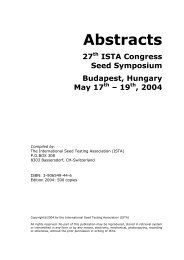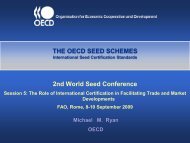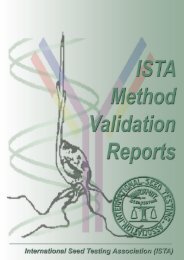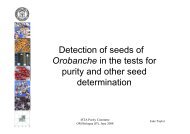Historical Paper - Volume 2 2008 - International Seed Testing ...
Historical Paper - Volume 2 2008 - International Seed Testing ...
Historical Paper - Volume 2 2008 - International Seed Testing ...
You also want an ePaper? Increase the reach of your titles
YUMPU automatically turns print PDFs into web optimized ePapers that Google loves.
H.A. JENSEN<br />
Table 3. Minimum mass (weights) (in g) for purity analysis of selected species in the ISTA Rules of 1931, 1956,<br />
1966 and 2005.<br />
Species 1931* 1931** 1956** 1966** 2005**<br />
Agrostis stolonifera 0.5 1 0.5 0.5 0.25<br />
Allium cepa 5 10 10 8 8<br />
Allium porrum 5 10 10 7 7<br />
Anethum graveolens 2 4 5 4 4<br />
Avena sativa 50 100 100 120 120<br />
Cucumis sativus 25 50 100 70 70<br />
Dactylis glomerata 1 2 2 3 3<br />
Daucus carota 1 2 5 3 3<br />
Festuca ovina 1 2 2 3 2.5<br />
Festuca rubra 1 2 2 3 3<br />
Lactuca sativa 2 4 5 3 3<br />
Linum usitatissimum 5 10 10 15 15<br />
Lolium perenne 3 6 5 6 6<br />
Lupinus angustifolius 100 200 500 450 450<br />
Pisum sativum 100 200 500 900 900<br />
Poa pratensis 0.5 1 1 1 1<br />
Trifolium repens 2 4 2 2 2<br />
Zea mays 200 400 500 900 900<br />
* Half working samples ** whole working samples<br />
Table 3 illustrates that for ten of the selected species, the working samples examined<br />
in 2005 were bigger than in 1931, for three species it were the same and for five species<br />
the size of the sample was reduced.<br />
In the ISTA Rules of 1931 it was obligatory to examine two replicates in the purity<br />
test. Since 1962 this became an option but still some laboratories test two working samples<br />
as part of their internal quality procedures.<br />
The tolerances calculated by Miles (1963) were based on an examination of a working<br />
sample corresponding to 2,300 chaffy seeds and 2,750 non-chaffy seeds (see 5.3). The<br />
ISTA Congress in 1965 did not find it necessary to distinguish between the two types of<br />
seeds, and it was decided that the purity examinations and the tolerances should be based<br />
on a sample corresponding to 2,500 seeds (Thomson 1965).<br />
The size of the working samples was from time to time discussed. In the Scandinavian<br />
Rules for seed testing of 1912 the size of the working sample was based on a working<br />
sample of 2,000 seeds.<br />
During the ISTA Workshop in 1973 half working samples (1,376 from Finland and<br />
1,273 from Denmark) were compared with the ISTA tolerances of 1963. The results<br />
showed that the laboratories in Finland and Denmark could use the ISTA tolerances<br />
without problems, even though the national examinations were performed on samples<br />
corresponding to 2,000 and not 2,500 seeds (Jensen 1974).<br />
12

















